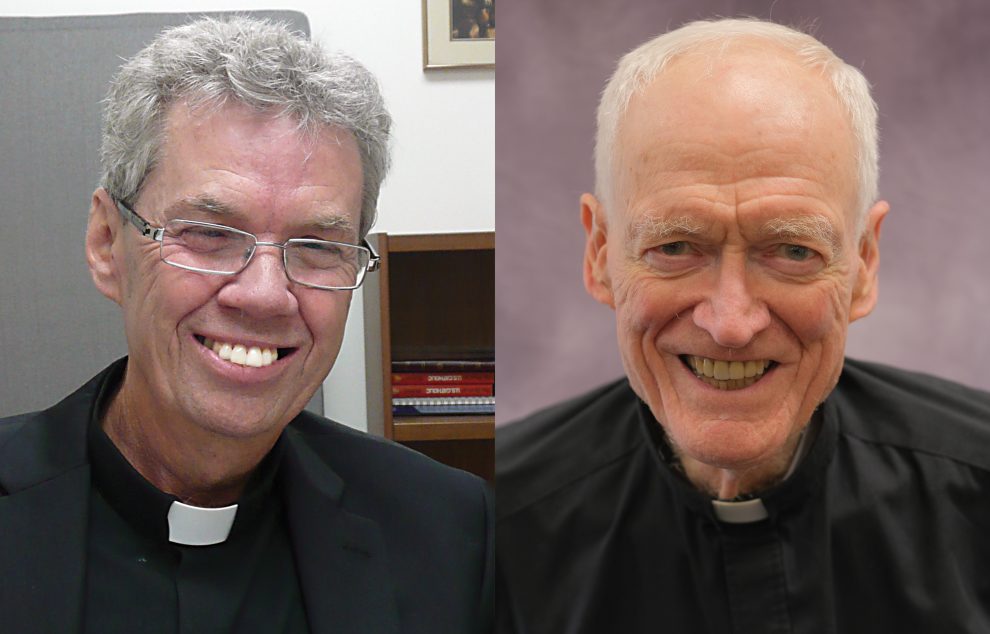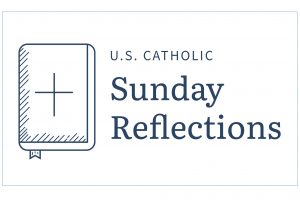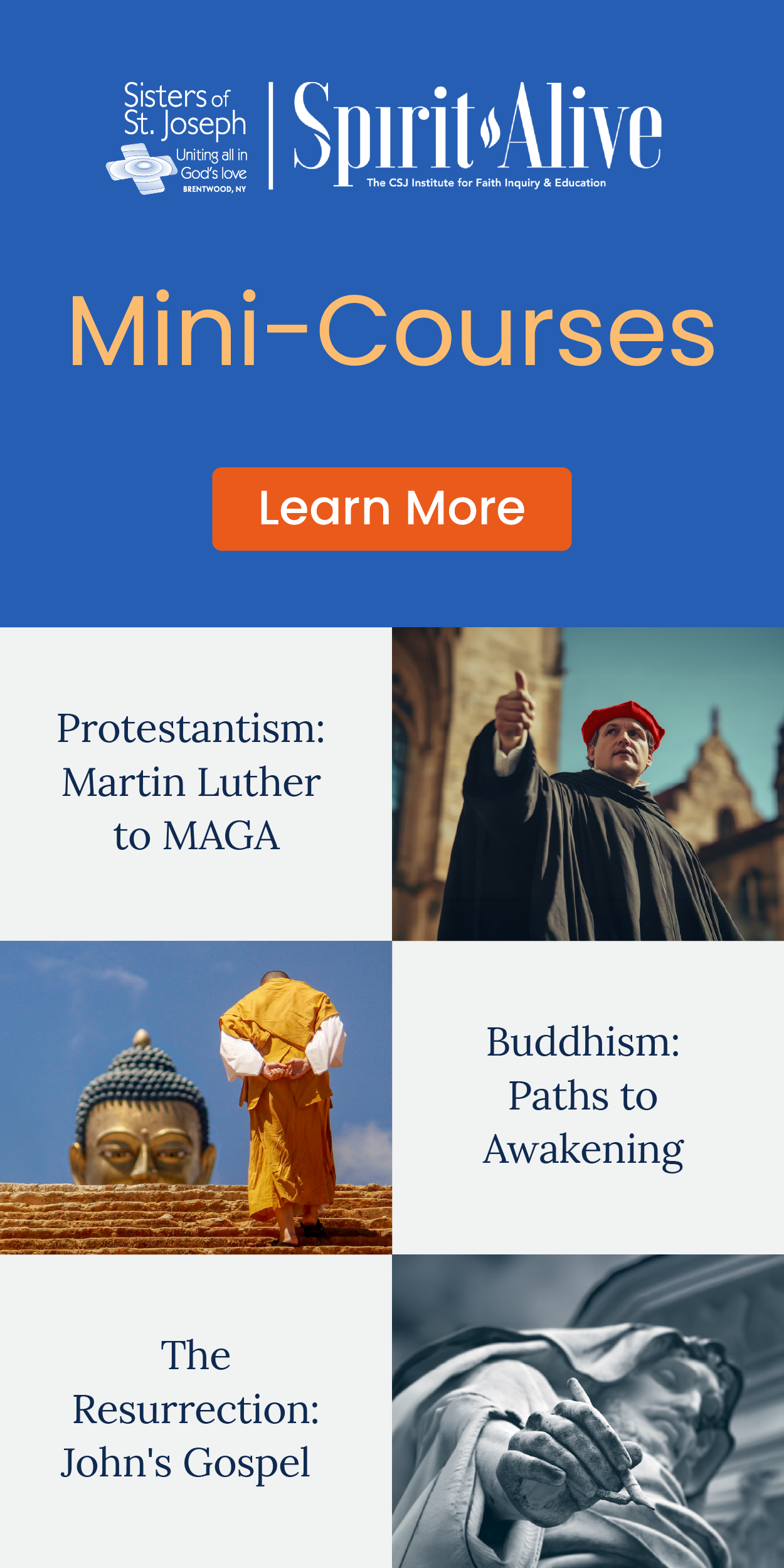For Claretian Fathers Mark Brummel and John Molyneux, both former editors-in-chief of U.S. Catholic, the enduring appeal of the magazine lies in people—the dedicated staff, faithful readers, and diverse writers who make this magazine feel like a living, breathing conversation among people of faith.
Brummel, who served as editor-in-chief from 1972 to 2002, and Molyneux, whose tenure lasted from 2002 until 2018, have a combined 46 years of editorial leadership. In this conversation, they reflect on everything from the Second Vatican Council and the Vietnam War to Dorothy Day’s cause for canonization and the art of crafting the perfect magazine title. In fact, Molyneux says that the title meetings were one of his favorite things about working here. “I never felt like any of us was in charge,” he says. “Everybody was listened to.”
The two share memories of newsroom collaboration, witty reader survey responses, and U.S. Catholic’s legacy of navigating controversial topics with honesty and care. “Since its beginning, the magazine has always had this really distinct mission,” says Brummel. “We’re very rooted in faith, very pastoral, but we’re also willing to ask the tough questions.”
Their conversation is more than reminiscing: It’s a witness to the spirit that continues to animate the magazine today. As it has been for the past 90 years, the magazine continues to depict a progressive, hopeful Catholicism rooted in community and dialogue and committed to building the kingdom of God.
Tell us a bit about how your journey with U.S. Catholic began.
Mark Brummel, C.M.F.: I became connected to U.S. Catholic in 1970, and in 1972, I became the editor. I always looked at my role more as a publisher than as an editor, because the magazine is lay run.
My mentor was Robert E. Burns, who was the executive editor from 1949 to 1984—a long time. I didn’t feel like I had to be in charge as the editor-in-chief. Burns was extremely good, and I learned from him as I went along. I think that was a good introduction for me into publishing, to work with him. There wasn’t a lot of pressure on me as an editor; I was the representative of the Claretians, but they were always very supportive of the magazine.
John Molyneux, C.M.F.: I joined the U.S. Catholic staff in 2002, and I was there until 2018. I realized that I worked at the magazine during three different popes. I remember the issue we did when St. Pope John Paul II died. I remember we were all together up on the top floor of our building watching while Joseph Ratzinger was elected pope. And then Pope Francis was also elected during my time there.
What’s your favorite memory of working at U.S. Catholic?
Brummel: For me it was the collaborative nature of the work; we really worked together. There was a common goal, and we had a progressive outlook that was respected everywhere. It was so important that we were working on the magazine together.
The bishop [of Chicago] wasn’t always in our favor. But we survived, and I think the Claretians were always extremely supportive in taking some of these things in stride.
I got involved with a lot of things I never would have gotten into without the magazine. I was part of the Associated Church Press—we were the first Catholic magazine to be part of that organization. It was so good to be in touch with so many different Protestant groups; it was fascinating. I know we’re still very much a part of that organization, and it’s good to know that our work continues there.
And then we started Dorothy Day’s cause for canonization; it was fascinating to see the tremendous support for that. We had to pass everything over to the Diocese of New York eventually, but we sponsored a seminar at Marquette University on her 100th birthday and even a seminar at the United Nations once.
And then of course there was the U.S. Catholic Award we gave out for many years.
Molyneux: The U.S. Catholic Award for Furthering the Cause of Women in the Church. One year we gave it to Dianna Ortiz, a former Ursuline sister who was tortured in Guatemala in the late 1980s. I actually knew her personally, because when I first came to Chicago I worked at a Catholic Worker house that was a house of hospitality for people from Central America who had been tortured, and she lived there. And then after I knew her she wrote a book and became very famous. It was really cool to have a reunion and see her again.
One of the things that I really liked about working at U.S. Catholic is that even as the staff changed over the many years I was there—and I don’t want to sound too pious, but it’s true—it felt like we were a small Christian community. Mark talked about collaboration, and I learned so much in the title and art meetings. I never felt like any of us was in charge. Everybody was listened to, and there was so much creativity during those meetings. The art director, Tom Wright, would be drawing while we talked, and everything just came together—the titles, the art, everything. I used to love going to those meetings.
We also got to meet such interesting people in the church. I remember when we interviewed theologian Elizabeth Johnson in the Chicago office. Heidi [Schlumpf] told her, “You are my rock star of Catholicism.” But the thing that I thought was so interesting about her is that, despite her fame, she looked like a nun. She has a really thick Brooklyn accent. I told her, “Oh my God, you talk like me!”
Johnson said a lot of really wonderful things in that interview, but one of the things that really stuck with me was her describing her friendship with Avery Dulles when they were both at Fordham. Theologically they couldn’t have been further apart, but they were good friends. She said, “Whenever I’m in town at 3 o’clock on a Sunday afternoon, my phone rings. It’s Avery, asking, ‘Beth, what are you doing for supper?’ ” They go out to dinner together every week.
How would you describe the mission of U.S. Catholic? Can you think of a specific story that really speaks to that mission?
Molyneux: We used to have a tagline about being in conversation with our readers. I love that—I think that’s what makes U.S. Catholic different. That’s what the magazine is all about—the Sounding Boards (reader surveys), You May Be Right (letters to the editor), things like that. In a lot of ways, these are my favorite parts of the magazine; they give people a chance to say what they want to say. The magazine’s readers may not believe everything the church teaches, but in some way they identify as Catholic.
One example of this is the recent story on cafeteria Catholics, which was really cool. But I think about some of the comments we’ve gotten over the years that were so witty and creative. I have a story I tell all the time: We did a Sounding Board essay on church music at Mass. Somebody wrote, “At my parish we sing ‘Sing a New Song’ every week. I wish we would take our own advice.” I just love that.
Brummel: The way we set up the Sounding Board with an article that people respond to is fascinating. That’s been part of the magazine since before I started here. It’s amazing how we cover even difficult things like abortion, and people respond. I think people recognize that not everything has easy answers, and they’re willing to deal with it.
I’ve been thinking about our coverage of the Vietnam War. In 1967, we published a really strong editorial against the war. At the time, there weren’t too many groups opposed to the war in Vietnam. That was such a powerful decision on the part of the editors. It really impressed me; so much so that I became part of the staff two years later. I was very much in favor of that decision. It had this kind of forward-looking, prophetic stance, which was very important for me.
Molyneux: I’ve been thinking about how if you look back at U.S. Catholic from the 1970s to the ’80s, it was a much more progressive church. I remember seeing a cover that said something like, “Christ has died, Christ is risen. So what?” We could never get away with that now.
There was something so great about that classic 1980s editorial voice.
Brummel: I always felt like the editors had a really good sense of humor. I know they spent a lot of time coming up with clever titles.
Molyneux: Right? The other one I remember is Sandra Schneider’s interview, which we titled “God is more than two men and a bird.” She hated that title. But that’s now a classic—it’s assigned in seminaries. It was really one of the first articles published in popular Catholic media about using inclusive language for God.
Is there anything you think has changed about U.S. Catholic since your time here?
Molyneux: I’m stumped on this one. I still read the print magazine. I use it for homilies—for so many things. Not just because it’s a Claretian magazine, but it’s the best Catholic magazine. Or at least the most in line with my vision. But I know you have to keep up with getting to people who are interested in reflecting on Catholicism, and that might not be in print anymore.
Brummel: I still read the magazine after all these years, and I find it fascinating. I don’t think it has lost quality; in fact, it’s increased in quality.
But I think we’ve always had a connection with the church that’s been very helpful. Vatican II has always been such a strong emphasis in U.S. Catholic. And yet we also reflect people—like in the cafeteria Catholic Sounding Board—and show that we’re open and ready to adjust to whatever is going on.
Since its beginning, the magazine has always had this really distinct mission. We’re very rooted in faith, very pastoral, but we’re also willing to ask the tough questions and talk about those tough topics. What does it mean to balance that prophetic part of our mission with the pastoral part of our mission?
Brummel: I think about LGBTQ+ Catholics and women; we’ve addressed both issues and supported writers with different perspectives. I think that’s where the church should be present today; in recognizing that we’re still struggling with these issues and we have to keep working on it.
Molyneux: Catholicism is such a big tent. I don’t know who came up with this, but I love the line: “We’re both Opus Dei and Dorothy Day.” That’s very true.
This article also appears in the June 2025 issue of U.S. Catholic (Vol. 90, No. 5, pages 16-20). Click here to subscribe to the magazine.
Header Image: Father John Molyneux, C.M.F. (left) and Father Mark Brummel, C.M.F.













Add comment